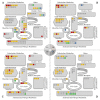Changes in the proteomic and metabolic profiles of Beta vulgaris root tips in response to iron deficiency and resupply
- PMID: 20565974
- PMCID: PMC3017792
- DOI: 10.1186/1471-2229-10-120
Changes in the proteomic and metabolic profiles of Beta vulgaris root tips in response to iron deficiency and resupply
Abstract
Background: Plants grown under iron deficiency show different morphological, biochemical and physiological changes. These changes include, among others, the elicitation of different strategies to improve the acquisition of Fe from the rhizosphere, the adjustment of Fe homeostasis processes and a reorganization of carbohydrate metabolism. The application of modern techniques that allow the simultaneous and untargeted analysis of multiple proteins and metabolites can provide insight into multiple processes taking place in plants under Fe deficiency. The objective of this study was to characterize the changes induced in the root tip proteome and metabolome of sugar beet plants in response to Fe deficiency and resupply.
Results: Root tip extract proteome maps were obtained by 2-D isoelectric focusing polyacrylamide gel electrophoresis, and approximately 140 spots were detected. Iron deficiency resulted in changes in the relative amounts of 61 polypeptides, and 22 of them were identified by mass spectrometry (MS). Metabolites in root tip extracts were analyzed by gas chromatography-MS, and more than 300 metabolites were resolved. Out of 77 identified metabolites, 26 changed significantly with Fe deficiency. Iron deficiency induced increases in the relative amounts of proteins and metabolites associated to glycolysis, tri-carboxylic acid cycle and anaerobic respiration, confirming previous studies. Furthermore, a protein not present in Fe-sufficient roots, dimethyl-8-ribityllumazine (DMRL) synthase, was present in high amounts in root tips from Fe-deficient sugar beet plants and gene transcript levels were higher in Fe-deficient root tips. Also, a marked increase in the relative amounts of the raffinose family of oligosaccharides (RFOs) was observed in Fe-deficient plants, and a further increase in these compounds occurred upon short term Fe resupply.
Conclusions: The increases in DMRL synthase and in RFO sugars were the major changes induced by Fe deficiency and resupply in root tips of sugar beet plants. Flavin synthesis could be involved in Fe uptake, whereas RFO sugars could be involved in the alleviation of oxidative stress, C trafficking or cell signalling. Our data also confirm the increase in proteins and metabolites related to carbohydrate metabolism and TCA cycle pathways.
Figures




Similar articles
-
Changes in iron and organic acid concentrations in xylem sap and apoplastic fluid of iron-deficient Beta vulgaris plants in response to iron resupply.J Plant Physiol. 2010 Mar 1;167(4):255-60. doi: 10.1016/j.jplph.2009.09.007. Epub 2009 Oct 24. J Plant Physiol. 2010. PMID: 19854536
-
Protein profile of Beta vulgaris leaf apoplastic fluid and changes induced by Fe deficiency and Fe resupply.Front Plant Sci. 2015 Mar 18;6:145. doi: 10.3389/fpls.2015.00145. eCollection 2015. Front Plant Sci. 2015. PMID: 25852707 Free PMC article.
-
Proteomic profiles of thylakoid membranes and changes in response to iron deficiency.Photosynth Res. 2006 Sep;89(2-3):141-55. doi: 10.1007/s11120-006-9092-6. Epub 2006 Sep 13. Photosynth Res. 2006. PMID: 16969715
-
Changes induced by Fe deficiency and Fe resupply in the root protein profile of a peach-almond hybrid rootstock.J Proteome Res. 2013 Mar 1;12(3):1162-72. doi: 10.1021/pr300763c. Epub 2013 Feb 8. J Proteome Res. 2013. PMID: 23320467
-
Salt stress response of membrane proteome of sugar beet monosomic addition line M14.J Proteomics. 2015 Sep 8;127(Pt A):18-33. doi: 10.1016/j.jprot.2015.03.025. Epub 2015 Apr 3. J Proteomics. 2015. PMID: 25845583 Review.
Cited by
-
Adaption of Roots to Nitrogen Deficiency Revealed by 3D Quantification and Proteomic Analysis.Plant Physiol. 2019 Jan;179(1):329-347. doi: 10.1104/pp.18.00716. Epub 2018 Nov 19. Plant Physiol. 2019. PMID: 30455286 Free PMC article.
-
Biotechnological Interventions in Tomato (Solanum lycopersicum) for Drought Stress Tolerance: Achievements and Future Prospects.BioTech (Basel). 2022 Oct 19;11(4):48. doi: 10.3390/biotech11040048. BioTech (Basel). 2022. PMID: 36278560 Free PMC article. Review.
-
Coated Hematite Nanoparticles Alleviate Iron Deficiency in Cucumber in Acidic Nutrient Solution and as Foliar Spray.Plants (Basel). 2023 Aug 29;12(17):3104. doi: 10.3390/plants12173104. Plants (Basel). 2023. PMID: 37687350 Free PMC article.
-
Knocking down mitochondrial iron transporter (MIT) reprograms primary and secondary metabolism in rice plants.J Exp Bot. 2016 Mar;67(5):1357-68. doi: 10.1093/jxb/erv531. Epub 2015 Dec 17. J Exp Bot. 2016. PMID: 26685186 Free PMC article.
-
NMR-Based Metabolic Profiling of Field-Grown Leaves from Sugar Beet Plants Harbouring Different Levels of Resistance to Cercospora Leaf Spot Disease.Metabolites. 2017 Jan 26;7(1):4. doi: 10.3390/metabo7010004. Metabolites. 2017. PMID: 28134762 Free PMC article.
References
-
- Landsberg E. Transfer cell formation in the root epidermis: A prerequisite for Fe-efficiency? J Plant Nut. 1982;5:415–432. doi: 10.1080/01904168209362970. - DOI
Publication types
MeSH terms
Substances
LinkOut - more resources
Full Text Sources
Medical
Molecular Biology Databases

